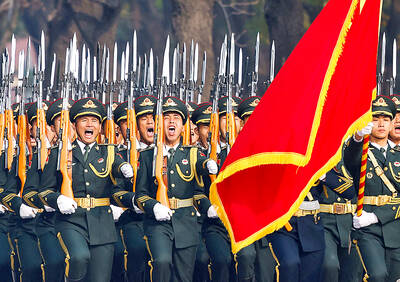The next installment of the annual Han Kuang military exercise is to reflect the military’s doctrinal shift from annihilation of the enemy to prevention of victory for the aggressor, a military official said yesterday.
The 34th Han Kuang exercise is to consist of a computer-assisted military simulation from Monday to Friday next week, as well as live-fire drills from July 4 to July 8, the general staff’s Chief of Joint Operations Major General Yeh Kuo-hui (葉國煇) told a news conference in Taipei.
The computer-assisted drill is designed to examine the soundness of the military’s Ku An operation plan and its success is not contingent on achieving victory, he said, adding that this would be a departure from past practice.

Photo: Chang Chia-ming, Taipei Times
The live-fire portion is to emphasize realism, mobilization of civilian assets, augmentation of the military’s reserve capabilities, combat under degraded command and control capabilities, and integration of the annual Wan An air raid drill, Yeh said.
For some portions of live-fire exercise, civilian assets — including Chunghwa Telecom Co (CHT, 中華電信), industries near the Ching Chuan Kang Air Base in Taichung and civilian drone operators — would be incorporated, he said.
Civilian organizations are to assist in tasks such as maintaining communication channels with cell sites, repairing damaged runways, battlefield imaging and information management, he said.
The growing gap in military resources between Taiwan and China has made the military’s traditional doctrine of emphasizing the destruction of enemy forces “not suited for the times and unachievable,” a Ministry of National Defense official said on condition of anonymity.
The live-fire drills are to involve mock air, sea and land battles during the day and night, with military units assuming attacking and defending roles, the official said.
The mock battles are intended to portray the asymmetric warfare conditions that the military believes to most realistically simulate a war with China, so it is reorienting its strategy toward preventing China’s People’s Liberation Army from conquering Taiwan, he said.
The doctrine — which had previously been elaborated by military officers — is now the guiding principle for building the armed forces, he said.
The focus on asymmetric warfare is to result in an increased emphasis on mobility, and distributing capabilities geographically and systematically to mitigate vulnerability from targeted strikes, he said.
In arms procurement, it signals a preference for weapons that prioritize efficiency, survivability, precision-strike capabilities and quality over quantity, he said.
The doctrine might favor the procurement of fast and stealthy systems that are compatible with swarm tactics, including rapid mine deployment-capable minelayers, submarines, guided missile attack boats, mobile air-defense systems, mobile anti-armor platforms, precision guided munition-firing tube artillery and self-propelled multiple launch rocket systems, he said.
The exercise’s arrangement shows that the military intends to distribute its systems and build up reserves by commandeering civilian drone resources, he said.

The Ministry of Foreign Affairs (MOFA) yesterday said it is closely monitoring developments in Venezuela, and would continue to cooperate with democratic allies and work together for regional and global security, stability, and prosperity. The remarks came after the US on Saturday launched a series of airstrikes in Venezuela and kidnapped Venezuelan President Nicolas Maduro, who was later flown to New York along with his wife. The pair face US charges related to drug trafficking and alleged cooperation with gangs designated as terrorist organizations. Maduro has denied the allegations. The ministry said that it is closely monitoring the political and economic situation

Conflict with Taiwan could leave China with “massive economic disruption, catastrophic military losses, significant social unrest, and devastating sanctions,” a US think tank said in a report released on Monday. The German Marshall Fund released a report titled If China Attacks Taiwan: The Consequences for China of “Minor Conflict” and “Major War” Scenarios. The report details the “massive” economic, military, social and international costs to China in the event of a minor conflict or major war with Taiwan, estimating that the Chinese People’s Liberation Army (PLA) could sustain losses of more than half of its active-duty ground forces, including 100,000 troops. Understanding Chinese

UNRELENTING: China attempted cyberattacks on Taiwan’s critical infrastructure 2.63 million times per day last year, up from 1.23 million in 2023, the NSB said China’s cyberarmy has long engaged in cyberattacks against Taiwan’s critical infrastructure, employing diverse and evolving tactics, the National Security Bureau (NSB) said yesterday, adding that cyberattacks on critical energy infrastructure last year increased 10-fold compared with the previous year. The NSB yesterday released a report titled Analysis on China’s Cyber Threats to Taiwan’s Critical Infrastructure in 2025, outlining the number of cyberattacks, major tactics and hacker groups. Taiwan’s national intelligence community identified a large number of cybersecurity incidents last year, the bureau said in a statement. China’s cyberarmy last year launched an average of 2.63 million intrusion attempts per day targeting Taiwan’s critical

‘SLICING METHOD’: In the event of a blockade, the China Coast Guard would intercept Taiwanese ships while its navy would seek to deter foreign intervention China’s military drills around Taiwan this week signaled potential strategies to cut the nation off from energy supplies and foreign military assistance, a US think tank report said. The Chinese People’s Liberation Army (PLA) conducted what it called “Justice Mission 2025” exercises from Monday to Tuesday in five maritime zones and airspace around Taiwan, calling them a warning to “Taiwanese independence” forces. In a report released on Wednesday, the Institute for the Study of War said the exercises effectively simulated blocking shipping routes to major port cities, including Kaohsiung, Keelung and Hualien. Taiwan would be highly vulnerable under such a blockade, because it